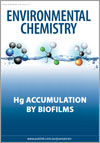EN17147Impact of anions on the surface organisation of lipid monolayers at the air–water interface
Environmental context. Lipids released from lysis of phytoplankton cells are enriched in the sea surface microlayer. Such surface-active organics can be transferred through bursting bubbles to sea-spray aerosols where they can influence atmospheric chemistry. The results presented here suggest that phospholipids combine more readily with SO42− than with Br−, leading to enrichment of organic-coated sulfate salts in marine aerosols.
EN17147 Abstract | EN17147 Full Text | EN17147PDF (969 KB) | EN17147Supplementary Material (232 KB) Open Access Article




